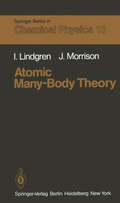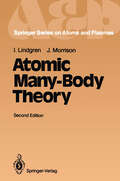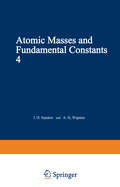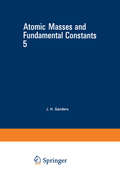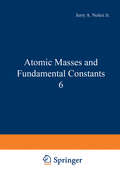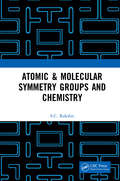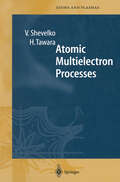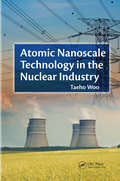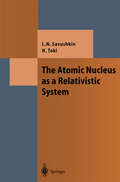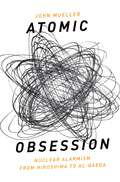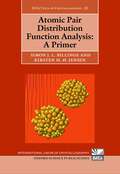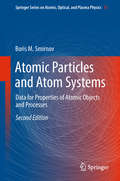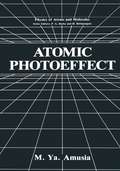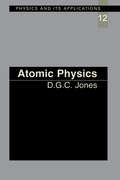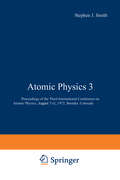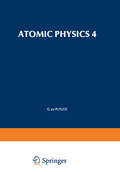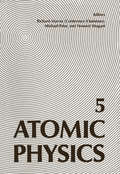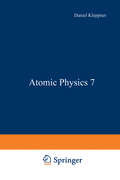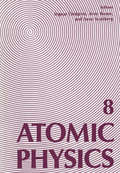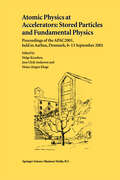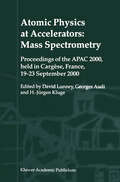- Table View
- List View
Atomic Many-Body Theory (Springer Series in Chemical Physics #13)
by I. Lindgren J. MorrisonThis book has developed through a series of lectures on atomic theory given these last eight years at Chalmers University of Technology and several oth er research centers. These courses were intended to make the basic elements of atomic theory available to experimentalists working with the hyperfine structure and the optical properties of atoms and to provide some insight into recent developments in the theory. The original intention of this book has gradually extended to include a wide range of topics. We have tried to provide a complete description of atomic theory, bridging the gap between introductory books on quantum mechanics - such as the book by Merzbacher, for instance - and present day research in the field. Our presentation is limited to static atomic prop erties, such as the effective electron-electron interaction, but the formalism can be extended without major difficulties to include dynamic properties, such as transition probabilities and dynamic polarizabilities.
Atomic Many-Body Theory (Springer Series on Atomic, Optical, and Plasma Physics #3)
by Ingvar Lindgren John MorrisonIn the new edition only minor modifications have been made. Some print ing errors have been corrected and a few clarifications have been made. In recent years the activity in relativistic many-body theory has increased con siderably, but this field falls outside the scope of this book. A brief summary of the recent developments, however, has been included in the section on "relativistic effects" in Chap. 14. In addition, only a very limited number of references have been added, without any systematic updating of the material. Goteborg, December 1985 l. Lindgren· J. Morrison Preface to the First Edition This book has developed through a series of lectures on atomic theory given these last eight years at Chalmers University of Technology and several oth er research centers. These courses were intended to make the basic elements of atomic theory available to experimentalists working with the hyperfine structure and the optical properties of atoms and to provide some insight into recent developments in the theory.
Atomic Masses and Fundamental Constants 4: Proceedings of the Fourth International Conference on Atomic Masses and Fundamental Constants held at Teddington England September 1971
by J. SandersThe Conference on Nuclear Masses and their Determination which was held at the Max Planck I nstitute in Mainz from 10 to 12 July 1956 resulted in the formation by the International Union of Pure and Applied Physics of a Commission on Atomic Masses and Related Constants. Under the auspices of this Commission conferences covering these subjects were held in Hamilton, Ontario (12-16 September, 1960), in Vienna (15-19 July 1963) and in Winnipeg (28 August-1 September 1967). After the last of these conferences the Commission felt that the position regarding nuclear masses was reasonably good and that as a consequence the fundamental constants should get more emphasis in future conferences. For this reason they were very pleased to accept an offer from the National Physical Laboratory to accept the main burden of organizing the Fourth International Conference on Atomic Masses and Fundamental Constants. An Organizing Committee was appointed with the members: J. H. Sanders, Chairman B. W. Petley, Secretary A. Horsfield, Treasurer P. Dean A. H. Wapstra. They were assisted by a Program Committee consisting of: A. H. Wapstra, Chairman E. R. Cohen A. Horsfield W. H. Johnson, Jr. J. H. Sanders J. Terrien.
Atomic Masses and Fundamental Constants 6
by Jerry A. NolenThe Sixth International Conference on Atomic Masses was held in East Lansing, Michigan, Sept. 18-21, 1979. The conference was initiated, organized, and sponsored by the Commission on Atomic Masses and Fundamental Constants of the International Union of Pure and Applied Physics. The members of the conference committee are listed below: W. Benenson, Chairman Michigan State University R. C. Barber University of-Manitoba E. R. Cohen Rockwell International Institute of Chemical Physics, V. I. Goldanskii Moscow J. C. Hardy Chalk River, Canada W. H. Johnson University of Minnesota E. Kashy Michigan State University Orsay, France R. Klapisch J. A. Nolen, Jr. Michigan State University R. G. H. Robertson Michigan State University E. Roeckl G. S. I. , Darmstadt B. N. Taylor National Bureau of Standards O. Schult IKF, Julich A. H. Wapstra IFO, Amsterdam N. Zeldes Racah Institute, Jerusalem The conference was a little different from the preceding one (in Paris, 1975) in that the fundamental constant aspects were limited to those directly related to atomic masses. The gap is to be filled by the second International Conference on Precision Measurement and Fundamental Constants which is now scheduled for June 1981 in Gaithersburg, Maryland. Only one of the seven sessions in this conference was devoted to fundamental constant determina tions. The conference was very strongly supported by the Department of Energy, the National Science Foundation, and the International Union of Pure and Applied Physics.
Atomic & Molecular Symmetry Groups and Chemistry
by S.C. RakshitAtomic Symmetry Groups, being continuous groups, are just a fallout of the Lie Groups and Lie Algebras. Atoms are structurally simpler than molecules but atomic symmetry is more complex than molecular symmetry. In quantum mechanics we study atoms first and then the molecules. In symmetry studies, we do just the reverse. In this book, apart from theories, the description of both the symmetry groups – atomic and molecular, are attended with adequate applications. Please note: Taylor & Francis does not sell or distribute the Hardback in India, Pakistan, Nepal, Bhutan, Bangladesh and Sri Lanka.
Atomic & Molecular Symmetry Groups and Chemistry
by S.C. RakshitAtomic Symmetry Groups, being continuous groups, are just a fallout of the Lie Groups and Lie Algebras. Atoms are structurally simpler than molecules but atomic symmetry is more complex than molecular symmetry. In quantum mechanics we study atoms first and then the molecules. In symmetry studies, we do just the reverse. In this book, apart from theories, the description of both the symmetry groups – atomic and molecular, are attended with adequate applications. Please note: Taylor & Francis does not sell or distribute the Hardback in India, Pakistan, Nepal, Bhutan, Bangladesh and Sri Lanka.
Atomic Multielectron Processes (Springer Series on Atomic, Optical, and Plasma Physics #23)
by Viatcheslav Shevelko Hiro TawaraAtomic Multielectron Processes is the first comprehensive collection of the data (mostly cross sections and methods) devoted to the multielectron transitions in atoms and ions induced by single collisions with charged particles and photons. The book covers the fundamental ranges of atomic physics which helps understanding the nature of many particle transitions.
Atomic Nanoscale Technology in the Nuclear Industry (Devices, Circuits, and Systems)
by Taeho WooDevelopments at the nanoscale are leading to new possibilities and challenges for nuclear applications in areas ranging from medicine to international commerce to atomic power production/waste treatment. Progress in nanotech is helping the nuclear industry slash the cost of energy production. It also continues to improve application reliability and safety measures, which remain a critical concern, especially since the reactor disasters in Japan. Exploring the new wide-ranging landscape of nuclear function, Atomic Nanoscale Technology in the Nuclear Industry details the breakthroughs in nanoscale applications and methodologies that are revolutionizing power production, biotechnology, and material science. Developments in atomic nanoscale technology have given us the ability to: Use ion beams to Investigate and optimize radiation energy losses at the nanoscopic level Assess nanoscopic safety circumstances involved in a reactor failure Analyze characteristics of nuclear spacecraft operating in the nanogravity of deep space Evaluate light collection enhancement for digital X-ray detection Apply brachytherapy using radioisotopes for cancer therapy Treat nuclear waste at the nanoscopic level Use systems-thinking decision making to analyze financial progress of nanotech in the energy industry Assess safety (and safety management methods) for nuclear nanomaterials used in plant operations Representing a first step in multi-combinatorial research, this text incorporates advanced studies that use Monte Carlo and solid-state measurement (including radiation detection) methods. Researchers used these to demonstrate the potential to upgrade methods of radiation protection and nuclear reactor operation (safety, waste disposal, etc.). The author also addresses how we can use nanotechnology to address industrial concerns and enhance nuclear medicine techniques. He highlights several nanomaterial systems and devices to illustrate developments in this area. About the Author: Taeho Woo launched the specialized field of atomic multinology (interdisciplinary research of nuclear technology), which combines the application of information technology, biotechnology, and nanotechnology in the nuclear industry.
Atomic Nanoscale Technology in the Nuclear Industry (Devices, Circuits, and Systems)
by Taeho WooDevelopments at the nanoscale are leading to new possibilities and challenges for nuclear applications in areas ranging from medicine to international commerce to atomic power production/waste treatment. Progress in nanotech is helping the nuclear industry slash the cost of energy production. It also continues to improve application reliability and safety measures, which remain a critical concern, especially since the reactor disasters in Japan. Exploring the new wide-ranging landscape of nuclear function, Atomic Nanoscale Technology in the Nuclear Industry details the breakthroughs in nanoscale applications and methodologies that are revolutionizing power production, biotechnology, and material science. Developments in atomic nanoscale technology have given us the ability to: Use ion beams to Investigate and optimize radiation energy losses at the nanoscopic level Assess nanoscopic safety circumstances involved in a reactor failure Analyze characteristics of nuclear spacecraft operating in the nanogravity of deep space Evaluate light collection enhancement for digital X-ray detection Apply brachytherapy using radioisotopes for cancer therapy Treat nuclear waste at the nanoscopic level Use systems-thinking decision making to analyze financial progress of nanotech in the energy industry Assess safety (and safety management methods) for nuclear nanomaterials used in plant operations Representing a first step in multi-combinatorial research, this text incorporates advanced studies that use Monte Carlo and solid-state measurement (including radiation detection) methods. Researchers used these to demonstrate the potential to upgrade methods of radiation protection and nuclear reactor operation (safety, waste disposal, etc.). The author also addresses how we can use nanotechnology to address industrial concerns and enhance nuclear medicine techniques. He highlights several nanomaterial systems and devices to illustrate developments in this area. About the Author: Taeho Woo launched the specialized field of atomic multinology (interdisciplinary research of nuclear technology), which combines the application of information technology, biotechnology, and nanotechnology in the nuclear industry.
The Atomic Nucleus as a Relativistic System (Theoretical and Mathematical Physics)
by Lev N. Savushkin Hiroshi TokiRelativity plays an important role in atomic nuclei, and, since the early 1970s, there has been increasing interest in, and literature on, the nucleus as a relativistic system. In fact, the relativistic treatment provides a powerful method to describe nuclear structure and reactions. It is thus an ideal time to collect and review the important landmarks in this book. Directed to advanced students and researchers, it explains both the underlying relativistic theory and compares predictions with actual experiments.
Atomic Obsession: Nuclear Alarmism from Hiroshima to Al-Qaeda
by John MuellerFollowing 9/11, Americans were swept up in a near hysteria-level fear of terrorists, especially of Islamic extremists working domestically. The government and media reports stoked fears that people living in the US have the desire and means to wreak extreme havoc and destruction. Early reports estimated slightly more than 300 al Qaeda operatives living in the United States. It wasn't long before this number became 2,000 or 5,000 domestic terrorists. As these estimates snowballed, so did spending on federal counterterrorism organizations and measures, spending which now totals over a trillion dollars. The federal government launched more covert operations in the name of fighting terrorist adversaries than they did in the entirety of the forty-five year Cold War. For each apprehension of a credible terrorist suspect, the US government created or re-organized two counterterrorism organizations. The scale of these efforts has been enormous, yet somehow they have not been proven to make Americans feels safe from what they perceive to be a massive terrorist threat. But how well-founded is this fear? Is the threat of terrorism in the United States as vast as it seems and are counterterrorism efforts effective and appropriately-scaled? It has not, statistically speaking, been efficient or successful. Only one alarm in 10,000 has proven to be a legitimate threat-the rest are what the authors refer to as "ghosts." These ghosts are enormous drains on resources and contribute to a countrywide paranoia that has resulted in widespread support and minimal critical questioning of massive expenditures and infringements on civil liberties, including invasions of privacy and questionably legal imprisonments. In Chasing Ghosts, John Mueller and Mark Stewart argue that the "ghost chase" occupying American fears, law enforcement, and federal spending persists because the public believes that there exists in the US a dire and significant threat of terrorism. The authors seek to analyze to what degree this is a true and to what degree the threat posed by terrorists in the US defends the extraordinary costs currently put towards their investigation. The chance that an American will be killed by a terrorist domestically in any given year is about one in four million (under present conditions). Yet despite this statistically low risk and the extraordinary amount of resources put towards combatting threats, Americans do not profess to feel any safer from terrorists. Until the true threat of domestic terrorism is analyzed and understood, the country cannot begin to confront whether our pursuit of ghosts is worth the cost.
Atomic Obsession: Nuclear Alarmism from Hiroshima to Al-Qaeda
by John MuellerFollowing 9/11, Americans were swept up in a near hysteria-level fear of terrorists, especially of Islamic extremists working domestically. The government and media reports stoked fears that people living in the US have the desire and means to wreak extreme havoc and destruction. Early reports estimated slightly more than 300 al Qaeda operatives living in the United States. It wasn't long before this number became 2,000 or 5,000 domestic terrorists. As these estimates snowballed, so did spending on federal counterterrorism organizations and measures, spending which now totals over a trillion dollars. The federal government launched more covert operations in the name of fighting terrorist adversaries than they did in the entirety of the forty-five year Cold War. For each apprehension of a credible terrorist suspect, the US government created or re-organized two counterterrorism organizations. The scale of these efforts has been enormous, yet somehow they have not been proven to make Americans feels safe from what they perceive to be a massive terrorist threat. But how well-founded is this fear? Is the threat of terrorism in the United States as vast as it seems and are counterterrorism efforts effective and appropriately-scaled? It has not, statistically speaking, been efficient or successful. Only one alarm in 10,000 has proven to be a legitimate threat-the rest are what the authors refer to as "ghosts." These ghosts are enormous drains on resources and contribute to a countrywide paranoia that has resulted in widespread support and minimal critical questioning of massive expenditures and infringements on civil liberties, including invasions of privacy and questionably legal imprisonments. In Chasing Ghosts, John Mueller and Mark Stewart argue that the "ghost chase" occupying American fears, law enforcement, and federal spending persists because the public believes that there exists in the US a dire and significant threat of terrorism. The authors seek to analyze to what degree this is a true and to what degree the threat posed by terrorists in the US defends the extraordinary costs currently put towards their investigation. The chance that an American will be killed by a terrorist domestically in any given year is about one in four million (under present conditions). Yet despite this statistically low risk and the extraordinary amount of resources put towards combatting threats, Americans do not profess to feel any safer from terrorists. Until the true threat of domestic terrorism is analyzed and understood, the country cannot begin to confront whether our pursuit of ghosts is worth the cost.
Atomic Pair Distribution Function Analysis: A Primer (International Union of Crystallography Texts on Crystallography #22)
by Prof Simon Billinge Assoc. Prof Kirsten JensenSince the early 1990s the atomic pair distribution function (PDF) analysis of powder diffraction data has undergone something of a revolution in its ability to do just that: yield important structural information beyond the average crystal structure of a material. With the advent of advanced sources, computing and algorithms, it is now useful for studying the structure of nanocrystals, clusters and molecules in solution or otherwise disordered in space, nanoporous materials and things intercalated into them, and to look for local distortions and defects in crystals. It can be used in a time-resolved way to study structural changes taking place during synthesis and in operating devices, and to map heterogeneous systems. Although the experiments are somewhat straightforward, there can be a gap in knowledge when trying to use PDF to extract structural information by modelling. This book addresses this gap and guides the reader through a series of real life worked examples that gradually increase in complexity so the reader can have the independence and confidence to apply PDF methods to their own research and answer their own scientific questions. The book is intended for graduate students and other research scientists who are new to PDF and want to use the methods but are unsure how to take the next steps to get started.
Atomic Particles and Atom Systems: Data for Properties of Atomic Objects and Processes (Springer Series on Atomic, Optical, and Plasma Physics #51)
by Boris M. SmirnovThis book presents physical units and widely used physical formulas, which are given together with conversion factors in various units. It includes frequently used atomic spectra and data for atoms, ions and molecules, as well as potential curves for diatomic molecules, and provides numerical parameters for transport phenomena in gases and plasmas. Further, the rate constants of a number of processes in atmospheric ionized air have been added to this second edition of the book. The numerical data has been selected from the information on atoms, atomic systems, atomic processes and models for atomic physics in this area, and the numerical parameters of atoms, ions and atom systems are included in periodical tables of elements.
Atomic Photoeffect (Physics of Atoms and Molecules)
by M.Ya. AmusiaThis book is devoted to the investigation of a rather prevalent process in nature: interaction of atoms with electromagnetic radiation. Primary attention is given to the low and intermediate photon energy region, from tens to hundreds of electron-volts. It is in this region that the probability of photon absorption and photoionization is largest. Data in this energy region are very interesting and useful in astrophysics and plasma physics, solid-state physics and quantum electronics, and in a number of other branches of science and technical applications. Formulae for hydrogen atom photoionization are given in almost all textbooks on quantum mechanics. Together with the limited amounts of experimental data available up to the beginning of the sixties, the formulae gave an impression of the completeness of the study of photoionization, of the absolute clarity of the mechanism of the process, and of the possibility of calculating rather easily its probability using the formulae.
Atomic Physics
by D.C.G JonesUsing the quantum approach to the subject of atomic physics, this text keeps the mathematics to the minimum needed for a clear and comprehensive understanding of the material. Beginning with an introduction and treatment of atomic structure, the book goes on to deal with quantum mechanics, atomic spectra and the theory of interaction between atoms and radiation. Continuing to more complex atoms and atomic structure in general, the book concludes with a treatment of quantum optics. Appendices deal with Rutherford scattering, calculation of spin-orbit energy, derivation of the Einstein B coefficient, the Pauli Exclusion Principle and the derivation of eigenstates in helium. The book should be of interest to undergraduate physics students at intermediate and advanced level and also to those on materials science and chemistry courses.
Atomic Physics
by D.C.G JonesUsing the quantum approach to the subject of atomic physics, this text keeps the mathematics to the minimum needed for a clear and comprehensive understanding of the material. Beginning with an introduction and treatment of atomic structure, the book goes on to deal with quantum mechanics, atomic spectra and the theory of interaction between atoms and radiation. Continuing to more complex atoms and atomic structure in general, the book concludes with a treatment of quantum optics. Appendices deal with Rutherford scattering, calculation of spin-orbit energy, derivation of the Einstein B coefficient, the Pauli Exclusion Principle and the derivation of eigenstates in helium. The book should be of interest to undergraduate physics students at intermediate and advanced level and also to those on materials science and chemistry courses.
Atomic Physics 3: Proceedings of the Third International Conference on Atomic Physics, August 7–11, 1972, Boulder, Colorado (pdf)
by Stephen SmithAtomic Physics 4
by G. PutlitzATOMIC PHYSICS 4 extends the series of books containing the invited papers presented at each "International Conference on Atomic Physics." FICAP, the fourth conference of this type since its foun dation in 1968, was held at the University of Heidelberg. The goal of these conferences, to cover the field of atomic physics with all its different branches, to review the present status of research, to revive the fundamental basis of atomic physics and to emphasize future developments of this field as well as its applications was met by more than thirty invited speakers, leaders in the field of atomic physics. Their talks were supplemented by more than two hundred contributed papers contained in the FICAP Book of Abstracts. This volume begins with papers given in honour and memory of E. U. Condon, to whom this conference was dedicated. It continues with articles on fundamental interactions in atoms and Quantum electrodynamics, on the fast progressing field of high energy heavy ion collisions and Quasi-molecules, on electronic and atomic collisions and the structure of electronic and ~-mesic atoms. The volume closes with contributions concerning the application of la sers in atomic physics, a new field of vastly increasing importance to fundamental experiments as well as applications. We feel that this book contains a very stimulating account of the present main streams of research in atomic physics and its possible future di rections.
Atomic Physics 5
by Richard MarrusThe Fifth International Conference on Atomic Physics was held July 26-30, 1976 in Berkeley, California. Invited talks were solicited which were representative of the most important developments since the fourth conference held in Heidelberg, Germany in 1974. In this volume, we have collected the manuscripts of the invited speakers, in the belief that they represent a guide to contemporary re search in atomic physics. Experimental work on such topics as the search for parity violation, spectroscopy and collision processes of fast, highly-stripped heavy ions, exotic atoms, high-Rydberg states, laser spectros copy, photoelectron spectroscopy, and others are described. The work described in these manuscripts is a clear mea sure of the continued vitality of our field. One unhappy event since the last conference was the passing of Dr. Victor William (Bill) Cohen (1911-1974) of Brookhaven National Laboratory. Bill was one of the scientists who recognized early the need for personal communication among atomic physicists and was the prime mover in establishing the present international conference series. Everyone who has enjoyed the stimulation of these conferences is indebted to Bill Cohen, and we dedicate this volume of the proceedings to his memory.
Atomic Physics 7
by Daniel KleppnerAtomic Physics 7 presents the manuscripts of the invited talks delivered at the Seventh International Conference of Atomic Physics, held at M.I.T. August 4-8, 1980. This conference continues the tradition of the earlier conferences by reviewing broad areas of fundamental atomic physics and related subjects. In addition to the invited talks, one hundred and ninety contributed papers were presented in poster sessions. Abstracts of the contributed papers have been printed separately in a small volume. Three hundred and fifty participants from thirteen nations attended the conference. One of the highlights of the conference was an historical talk by Professor Abraham Pais of Rockefeller University entitled "The Birth of the Quantum Theory: Planck". The manuscript of this talk will be published elsewhere. Dr. John Bailey presented a talk on the proton-antiproton system at low energy, but was unable to provide a manuscript for this volume. Also omitted from these Proceedings, but one of the highlights of the Conference, are the comments by Professor I. I. Rabi, an active participant who chaired one session and spent an evening discussing science, history and public policy with graduate students at the Conference.
Atomic Physics 8: Proceedings of the Eighth International Conference on Atomic Physics, August 2–6, 1982, Göteborg, Sweden
by I. LindgrenThe Eighth International Conference on Atomic Physics was held at Ch~lmers University of Technology, Goteborg, Sweden on August 2-6, 1982. Following the tradition established by earlier conferences in the series, it was attended by 280 participants from 24 countries. A total of 28 invited talks were delivered at the conference. These talks, which are presented in this volume, covered a wide range of topics in atomic physics in a broad sense. They extend from very basic problems (e.g., the interpretation of quantum mechanics in light of Bell's theorem and the feasibility of relativistic many-body calculations) to applied problems (e.g., laser detection of trace elements and spectroscopy of chemisorbed molecules). Professor M.Ya. Amusia was unable to attend the conference but his invited paper is included here. Professor V.S. Letokhov presented a talk entitled "Prospects of Laser Detection of Very Rare Isotopes, but was unable to provide a manuscript. At the conference, 175 post ers were presented. Abstracts have been published in a separate volume. It is very much appreciated that all the 1981 Nobel laureates, Nicolaas Bloembergen, Arthur Schawlow and Kai Siegbahn, were able to attend and deliver their invited talks. Professor Schawlow summed up the conference and this too is presented here. The con ference also benefited considerably from the presence of Professor 1.1. Rabi, who gave a much appreciated talk at the conference dinner. As this talk was given without a manuscript, it could unfortunately not be included here.
Atomic Physics at Accelerators: Proceedings of the APAC 2001, held in Aarhus, Denmark, 8–13 September 2001
by Helge Knudsen Jens Ulrik Andersen Heinz-Jürgen KlugeThis volume contains the proceedings of the third Euroconference on Atomic Phys ics at Accelerators (APAC 2001), with the title Stored Particles and Fundamental Physics. It was held in Aarhus, Denmark, from September 8 to 13 at the Marselis Hotel located near the beach and the Marselis Woods outside Aarhus, but some of the activities took place at the Department of Physics, University of Aarhus. The conference was sponsored by the Commission of the European Union (Contract No. ERBFMMACT980469) and also by the Danish Research Foundation through ACAP (Aarhus Center for Atomic Physics). The meeting was focused on the application of storage rings for atomic physics, and there are two fairly small rings in Aarhus, ASTRID (Aarhus STorage Ring for Ions,Denmark) and ELISA (ELectrostatic Ion Storage ring, Aarhus). The research at these rings has contributed to the strong position of European Science in this field. Both rings are designed according to unique concepts. ASTRID is a dual purpose ring, which half the time stores electrons for the generation of low-energy synchrotron radiation. The storage of negative particles has also been a unique feature for the application of ASTRID as an ion storage ring.
Atomic Physics at Accelerators: Proceedings of the APAC 2000, held in Cargèse, France, 19–23 September 2000
by David Lunney Georges Audi Heinz-Jürgen KlugeThe search for examples of proton radioactivity has resulted in the discovery of a large number of proton emitters in the region 50 < Z < 84 [1]. Many of these proton emitters and their daughters are also a-emitters, and in some cases the a-decay chain from the daughter terminates on a nuclide closer to stability whose mass excess is known. This opens up the possibility of using a-and proton-decay Q-values to determine the mass excesses of a large group of nuclei connected by particle decay. The Q-values are derived from the measured kinetic energies of the emitted protons or a-particles. Where the decay chains are not connected to nuclei with known mass excesses, proton separation energies can be measured in some cases and derived in others. For the a-decay ofthe parent nucleus (Z, A) to the daughter (Z - 2, A - 4), the energy and momentum relations used to convert between Q-value, mass (M) and mass excess (ME) are: M(4He)E", (1) M(Z - 2, A - 4)Erecoil, (2) Q", E", + Erecoi\, ME(Z, A) Q", + ME(Z - 2, A - 4) + ME(4He). (3) In practice, one uses M(4He) ~ 4 and M(Z - 2, A - 4) (A - 4), so that Equation (3) becomes ME(Z, A) = E", (_A_) + ME(Z - 2, A - 4) + ME(4He). (4) A -4 Similarly, for protons, we have ME(Z, A) = Ep(_A_) +ME(Z - 1, A-I) +ME(lH).
